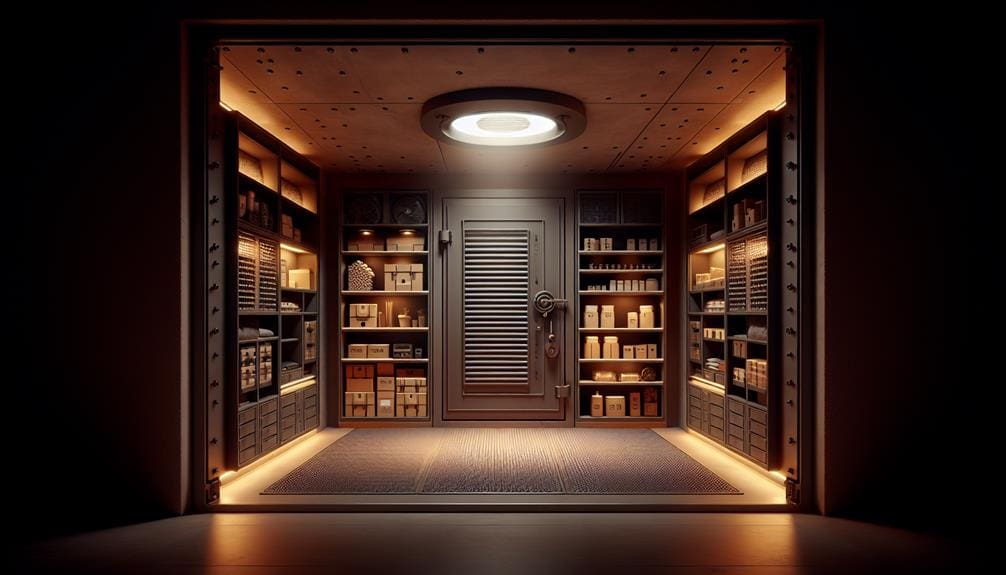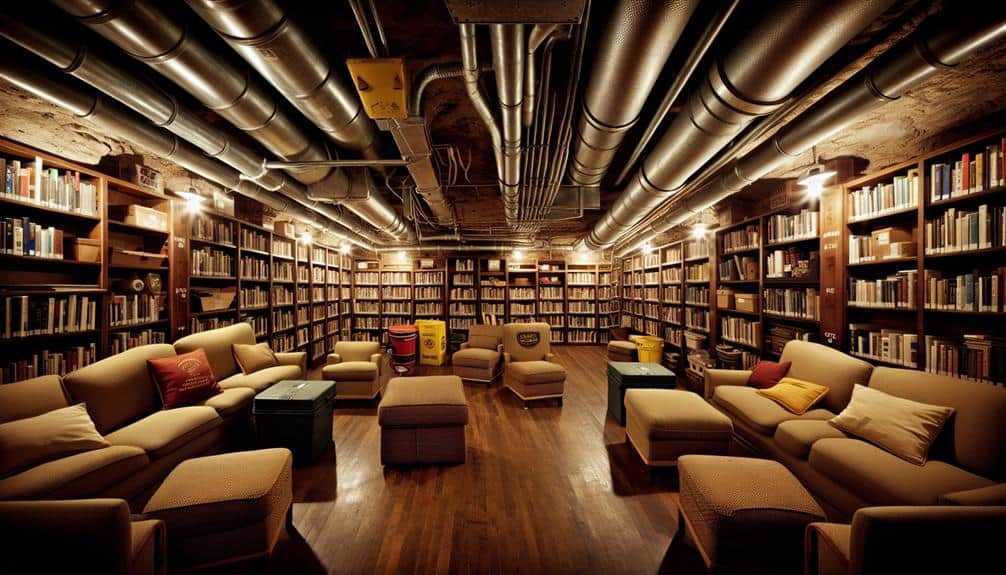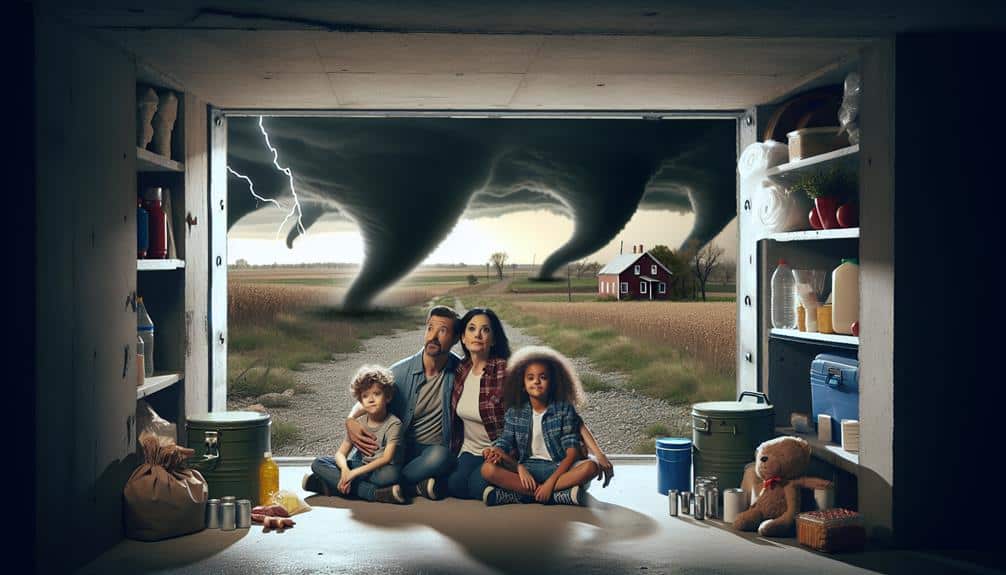We recommend the best storm shelter locations with exceptional ventilation systems for safety. Underground bunkers and basement shelters are reinforced with advanced air systems. School safe rooms and community centers provide structurally sound spaces with robust ventilation. Residential safe rooms focus on air quality by carefully placing intake and exhaust vents. Commercial building shelters and public libraries use HEPA filters and backup power for ventilation. Fire stations and hospital safe areas employ medical-grade air filtration and automated airflow controls. Custom home shelters offer tailored ventilation solutions. Each option prioritizes air quality and structural integrity during emergencies to stay informed.
Key Points
- Underground bunkers provide maximum safety with reinforced concrete and advanced ventilation systems.
- School safe rooms feature reinforced walls and robust ventilation, focusing on student safety.
- Residential safe rooms prioritize air quality with well-placed intake and exhaust vents.
- Hospital safe areas include medical-grade air filtration and backup generators for continuous operation.
Underground Bunkers
Underground shelters, often built with reinforced concrete, provide essential protection against severe weather events while incorporating advanced ventilation systems to maintain air quality and safety. These shelters utilize hidden entrances, guaranteeing an added layer of security and discretion. Such entrances often blend seamlessly into the surroundings, making them hard to detect and enhancing our overall safety during emergencies.
The fortified structures of these shelters are designed to withstand extreme weather conditions, including tornadoes and hurricanes. By using materials like reinforced concrete and steel, they secure structural integrity even under duress.
To cater to our need for independence and self-reliance, these shelters are equipped with various emergency supplies. These include non-perishable food, water purification systems, and first aid kits. By having these supplies on hand, we can sustain ourselves for extended periods without external assistance.
Furthermore, sustainable features are essential to modern underground shelters. These might include solar panels for generating electricity, rainwater harvesting systems, and energy-efficient lighting. Advanced ventilation systems not only maintain air quality but also regulate temperature and humidity, creating a livable environment.
Basement Shelters
Unlike underground bunkers, basement shelters offer an easily accessible and practical solution for immediate protection during severe weather events. We can quickly reach our basement without the need for external structures, making it ideal for last-minute safety. These shelters aren't only convenient but also versatile, often doubling as functional living spaces.
When setting up a basement shelter, ventilation is paramount. Installing a high-efficiency particulate air (HEPA) filter system guarantees clean air circulation, significant during extended stays. Additionally, we should consider battery-operated fans to maintain airflow if power is lost.
Stocking our shelter supplies is essential for preparedness. This includes non-perishable food, water, first-aid kits, flashlights, and blankets. A NOAA weather radio is indispensable for receiving real-time updates. We should also include basic tools and personal hygiene items.
Conducting regular emergency drills can notably enhance our readiness. By practicing evacuation routes and sheltering procedures, we familiarize ourselves with the process, reducing panic during an actual emergency. It's wise to involve all household members, ensuring everyone knows their responsibilities and locations of critical supplies.
School Safe Rooms
Designing school safe rooms involves integrating advanced safety features to guarantee the protection of students and staff during severe weather events. Our primary focus is on student safety, securing that these shelters are equipped to handle school lockdowns and emergency drills efficiently. By doing so, we can create an environment where everyone feels secure and prepared.
We start by selecting a location within the school that's both accessible and structurally sound. Reinforced walls and ceilings are essential to withstand high winds and flying debris. Ventilation systems are critical; these systems must provide fresh air while maintaining structural integrity. Advanced filtration can protect against contaminants, ensuring a breathable environment for extended periods.
Integrating community resources into our design can enhance the functionality of school safe rooms. Partnerships with local emergency services can guarantee that our shelters are well-stocked with necessary supplies and communication tools. During school lockdowns, these rooms should serve as multi-purpose spaces, allowing for comfortable shelter during drills and real emergencies.
Ultimately, our goal is to create safe rooms that serve as havens of security. By focusing on technical precision and leveraging community resources, we can guarantee that our students and staff are protected, no matter the circumstances.
Community Centers
Community centers serve as vital hubs for shelter and safety during severe weather, requiring strong ventilation systems to ensure air quality and structural integrity. In these settings, park shelters and recreational facilities often act as primary safe zones. Ensuring they have sturdy ventilation systems is non-negotiable.
Proper ventilation prevents the buildup of carbon dioxide and maintains breathable air, especially when many people are confined in one space. Additionally, ventilation systems in park shelters must be designed to withstand high wind speeds and debris impact, ensuring continuous operation even during the most severe storms.
In addition to recreational facilities, shopping malls and office buildings frequently serve as community storm shelters. These locations are typically built with extensive HVAC systems that can be adapted to provide additional ventilation in emergency conditions. However, we must verify that these systems are resilient against power outages and can function independently of the main power grid, possibly through backup generators.
Structural reinforcements around ventilation ducts are essential to prevent damage from flying debris, ensuring these systems remain operational. Prioritizing these technical details in our community centers ensures that we can maintain freedom and safety for all, even in the toughest weather conditions.
Residential Safe Rooms

Let's start by focusing on installation and design tips for residential safe rooms, ensuring we incorporate robust ventilation systems.
We should prioritize features that maintain air quality and prevent carbon dioxide buildup.
Properly designed ventilation can greatly enhance the safety and comfort of these critical spaces.
Installation and Design Tips
When installing a residential safe room, ensuring proper ventilation is essential for maintaining air quality and safety during extended use. We need to factor in shelter aesthetics and cost-efficient options without compromising functionality. A well-designed ventilation system should blend seamlessly with the shelter's interior and exterior, maintaining a cohesive look.
First, let's identify the best placement for intake and exhaust vents. Positioning them high on opposite walls promotes effective cross-ventilation, ensuring a continuous flow of fresh air. Installing adjustable vents allows us to control airflow based on occupancy and external conditions.
Next, we should select materials that are both durable and aesthetically pleasing. Stainless steel or powder-coated metal vents are excellent for their longevity and minimal maintenance. They also contribute to the shelter's overall aesthetic, offering a sleek, modern appearance.
When it comes to cost-efficient options, think about using a combination of passive and active ventilation systems. Passive vents rely on natural airflow and are budget-friendly, while battery-operated fans can enhance circulation when necessary. This hybrid approach balances cost and performance, making it an appealing solution for residential safe rooms.
Ventilation System Benefits
Proper ventilation systems in residential safe rooms offer significant benefits by ensuring air quality and reducing the risk of suffocation during emergencies. When we're hunkering down, it's essential to maintain a constant flow of fresh air. Efficient air circulation not only prevents the buildup of carbon dioxide but also helps to filter out contaminants.
One major advantage of these systems is their energy efficiency. By incorporating energy-efficient fans and filters, we can maintain ideal air quality without consuming excessive power. This is particularly important when relying on backup generators or limited power sources during a storm.
Another key benefit is temperature control. Effective ventilation systems help regulate the internal temperature of the safe room, preventing it from becoming too hot or too cold. This is essential for our comfort and well-being, as extreme temperatures can exacerbate stress or health conditions.
Moreover, the health benefits of proper ventilation can't be overstated. Clean, circulated air reduces the risk of respiratory issues, headaches, and other health complications that can arise from poor air quality. In emergencies, the last thing we need is compromised health due to inadequate ventilation.
Commercial Building Shelters
In commercial buildings, storm shelters must include advanced ventilation systems to guarantee occupant safety and air quality during extended use. It's evident that the specific commercial building features, such as size, occupancy, and layout, influence the design and placement of storm shelters. These shelters should be strategically located within the building to provide easy access and quick evacuation routes.
Compliance with storm shelter regulations is non-negotiable. According to the Federal Emergency Management Agency (FEMA) guidelines, storm shelters in commercial buildings must be capable of withstanding extreme weather conditions and should include ventilation systems that ensure adequate air exchange. These systems not only filter out contaminants but also help in maintaining a stable internal environment, essential during prolonged occupancy.
Moreover, the ventilation units should be equipped with backup power sources to function seamlessly during power outages, which are common during severe storms. High-efficiency particulate air (HEPA) filters ensure that the air remains free from harmful particles, while automated controls can monitor and adjust airflow as needed.
Public Library Safe Zones

Public libraries must integrate secure safe zones with advanced ventilation systems to guarantee the safety and air quality for patrons during severe weather events. Our public libraries serve as crucial community hubs, and their transformation into reliable storm shelters is essential. By incorporating HEPA filtration and robust air exchange systems, we can make sure that air quality remains optimal during an emergency.
Strategically locating these safe zones near entrances maximizes accessibility, especially for those arriving via public transportation. This ensures that everyone, including individuals with mobility issues, can quickly reach safety. Additionally, these shelters should be spacious enough to accommodate a significant number of patrons, ensuring no one is left vulnerable.
Comparatively, while park shelters offer open spaces and basic cover, they lack the advanced air filtration systems needed during severe weather. Public library safe zones, on the other hand, can be equipped with reinforced walls and ceilings to withstand high winds and flying debris, providing superior protection.
Fire Station Shelters
Let's examine fire station shelters, which offer unparalleled accessibility and robust safety measures.
These shelters are equipped with advanced ventilation systems designed to maintain air quality during emergencies.
Their proximity to emergency response teams guarantees rapid assistance and heightened security for occupants.
Accessibility and Safety Measures
Guaranteeing both accessibility and safety, fire station shelters are equipped with state-of-the-art ventilation systems and clearly marked emergency exits. We prioritize shelter accessibility, making certain that entrances are wide and unobstructed to accommodate everyone, including those with mobility impairments. These shelters are strategically located within fire stations, making sure they're easy to find and reach during emergencies.
Safety measures in fire station shelters are robust, starting with their ventilation systems. These systems are designed to maintain air quality and prevent the buildup of harmful gases, ensuring that occupants remain safe and comfortable. Additionally, the shelters are constructed with reinforced materials to withstand severe weather conditions, providing a secure refuge.
Emergency exits are clearly marked and easily accessible, allowing for quick evacuation if needed. Fire station personnel are trained in emergency response and are available to assist shelter occupants, further enhancing overall safety.
Advanced Ventilation Systems
Our advanced ventilation systems in fire station shelters are engineered to provide the best air circulation and maintain a safe environment during emergencies. We've meticulously designed these systems to enhance both airflow dynamics and energy efficiency, guaranteeing that even in the most vital situations, occupants remain protected and comfortable.
The ventilation design incorporates high-efficiency particulate air (HEPA) filters, which are essential for removing airborne contaminants. This maintains that the air quality remains ideal, even when external conditions are hazardous.
By focusing on airflow dynamics, we achieve consistent and uniform air distribution throughout the storm shelter. This minimizes the risk of hot spots or areas with stagnant air, which can be harmful in confined spaces.
Energy efficiency is a core aspect of our system. By utilizing variable speed fans and smart ventilation controls, we can adjust airflow based on occupancy and external conditions, reducing energy consumption without compromising safety. This not only supports sustainability but also guarantees that the shelter remains operational for extended periods, an optimal factor during prolonged emergencies.
In essence, our approach to advanced ventilation systems combines technical precision with a steadfast commitment to safety, ensuring a reliable refuge for all who seek shelter during storms.
Emergency Response Proximity
Proximity to emergency response units, such as fire stations, greatly enhances the effectiveness and safety of storm shelters. When our storm shelters are located near fire stations, we benefit from quicker response times and immediate access to personnel with emergency response training. This proximity guarantees that help is readily available, maximizing our safety during severe weather events.
Furthermore, the effectiveness of our shelters' ventilation systems is essential. Fire stations are equipped with advanced ventilation systems designed to handle emergencies, and by situating shelters nearby, we can leverage this expertise. These systems can mitigate risks associated with poor air quality and guarantee continuous airflow, crucial during extended sheltering periods.
Shelter proximity to emergency response units also plays a pivotal role in coordinating rescue operations. Firefighters, trained in rapid response and rescue, can reach us swiftly, reducing potential casualties and damage. This prompt intervention is especially important for those with medical conditions or limited mobility.
In essence, locating storm shelters near fire stations not only improves our access to trained responders but also enhances the overall effectiveness of our ventilation systems, ensuring a safer and more secure environment during emergencies.
Hospital Safe Areas

Hospital safe areas, equipped with advanced ventilation systems, provide vital protection and air quality during severe storms. These shelters are designed to maintain a sterile environment, ensuring that patients, staff, and visitors remain safe from airborne contaminants.
Unlike office buildings and shopping malls, hospital safe areas prioritize medical-grade air filtration to prevent the spread of pathogens while offering robust structural integrity against storm damage.
We recognize that hospitals must maintain operational continuity, especially during emergencies. As a result, their safe areas are fortified with reinforced walls and ceilings, capable of withstanding high winds and flying debris. The ventilation systems in these shelters are equipped with HEPA filters and UV light sterilization to guarantee the utmost air purity.
Additionally, these systems are designed to operate independently of the hospital's main power grid, using backup generators to guarantee continuous functionality. This autonomy is essential for maintaining life-support systems and other critical medical equipment.
In contrast to the more general-purpose designs found in office buildings and shopping malls, hospital safe areas are meticulously engineered to safeguard both human life and medical operations. This focus on safety and functionality underscores their important role in storm preparedness.
Custom Home Shelters
While hospital safe areas prioritize medical-grade air filtration and structural integrity, custom home shelters offer personalized solutions to protect families during severe storms. Our approach to custom design guarantees each shelter meets specific needs, whether we're dealing with limited space or unique family requirements. Customization allows us to optimize both safety and comfort.
Incorporating a robust ventilation system is essential. Proper ventilation isn't just about comfort; it guarantees a continuous supply of fresh air, reduces humidity, and prevents the buildup of dangerous gases. In confined spaces, like storm shelters, the importance of ventilation can't be overstated. We utilize top-tier HEPA filters and strategically placed vents to maintain air quality even during prolonged occupancy.
Our custom designs often include reinforced materials, strategically placed escape hatches, and emergency communication systems. We don't just build shelters; we build peace of mind. By integrating these elements, we ensure our shelters offer maximum protection without compromising on the freedom to breathe easy.
Frequently Asked Questions
How Do Ventilation Systems Prevent Mold and Mildew in Storm Shelters?
Ventilation systems provide essential benefits by circulating fresh air, reducing humidity, and effectively controlling moisture levels. This mold prevention strategy guarantees our storm shelters remain safe, sanitary, and free from harmful mildew, promoting a healthier environment.
What Are the Maintenance Requirements for Storm Shelter Ventilation Systems?
How do we guarantee our shelters stay safe? Regular inspections and filter changes are essential for storm shelter ventilation systems. These practices prevent blockages, maintain air quality, and sustain peak performance, giving us peace of mind and freedom.
Can Ventilation Systems in Storm Shelters Filter Out Chemical Contaminants?
Can ventilation systems in storm shelters filter out chemical contaminants? Yes, with proper chemical filtration, these systems can meet safety standards. Their effectiveness depends on the filters' quality and maintenance, ensuring we're protected from harmful substances.
Are There Energy-Efficient Ventilation Options for Storm Shelters?
We can achieve energy-efficient ventilation in our storm shelters by utilizing passive cooling techniques and solar-powered ventilation systems. These options guarantee safety, reduce dependency on grid power, and promote a sustainable, self-sufficient environment during emergencies.
How Do You Retrofit an Existing Shelter With a Modern Ventilation System?
When we explore retrofitting an existing shelter, the process offers benefits like enhanced air quality and safety. We need to weigh cost considerations and follow installation steps meticulously to guarantee peak performance and peace of mind.


